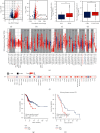Prognostic Value and Potential Regulatory Mechanism of H19 in Stomach Adenocarcinoma
- PMID: 36090894
- PMCID: PMC9452980
- DOI: 10.1155/2022/7702626
Prognostic Value and Potential Regulatory Mechanism of H19 in Stomach Adenocarcinoma
Abstract
The first lncRNA discovered, H19, has been found to participate in the regulation of diverse biological processes, including the pathogenesis of stomach adenocarcinoma. In addition to its oncogenic function in tumor formation, a high level of H19 in tumor tissues has also been reported to be an indicator for poor prognosis. However, although many previous works have investigated the level of H19 as an independent indicator for prognosis, the real value of H19 in predicting survival has rarely been evaluated. In this study, we established a prognostic model and nomogram for stomach adenocarcinoma by combining the expression level of H19 with traditional indices, which showed the value of H19 in predicting the survival rates of patients. In addition, we investigated the mechanism underlying the correlation of the H19 level in cancer tissue with poor prognosis in patients. Our results showed that H19 could function as ceRNA by sponging five miRNAs, which may promote the progression of cancer.
Copyright © 2022 Hongyuan Guo et al.
Conflict of interest statement
The authors declare that they have no conflicts of interest.
Figures




Similar articles
-
Long Non-Coding H19 in Lymphocytes: Prognostic Value in Acute Ischemic Stroke Patients.Pharmaceuticals (Basel). 2024 Jul 31;17(8):1008. doi: 10.3390/ph17081008. Pharmaceuticals (Basel). 2024. PMID: 39204113 Free PMC article.
-
LncRNA H19 regulates PI3K-Akt signal pathway by functioning as a ceRNA and predicts poor prognosis in colorectal cancer: integrative analysis of dysregulated ncRNA-associated ceRNA network.Cancer Cell Int. 2019 May 30;19:148. doi: 10.1186/s12935-019-0866-2. eCollection 2019. Cancer Cell Int. 2019. PMID: 31164794 Free PMC article.
-
The prognostic value of COL3A1/FBN1/COL5A2/SPARC-mir-29a-3p-H19 associated ceRNA network in Gastric Cancer through bioinformatic exploration.J Cancer. 2020 Jun 16;11(17):4933-4946. doi: 10.7150/jca.45378. eCollection 2020. J Cancer. 2020. PMID: 32742441 Free PMC article.
-
Long non-coding RNA H19 and cancer: A competing endogenous RNA.Bull Cancer. 2019 Dec;106(12):1152-1159. doi: 10.1016/j.bulcan.2019.08.011. Epub 2019 Nov 18. Bull Cancer. 2019. PMID: 31753509 Review.
-
The Interplay of LncRNA-H19 and Its Binding Partners in Physiological Process and Gastric Carcinogenesis.Int J Mol Sci. 2017 Feb 20;18(2):450. doi: 10.3390/ijms18020450. Int J Mol Sci. 2017. PMID: 28230721 Free PMC article. Review.
References
LinkOut - more resources
Full Text Sources

